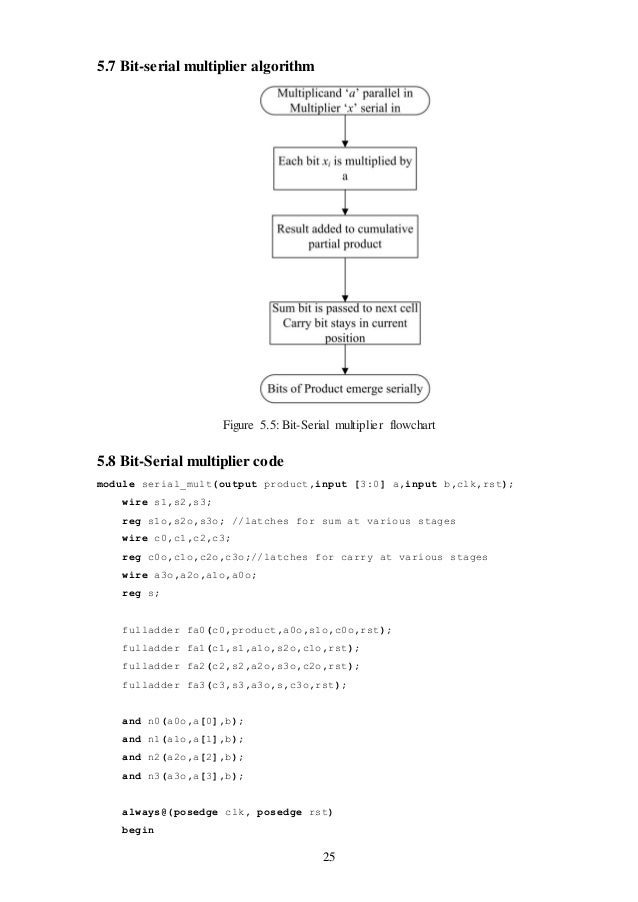4 Bit Serial Multiplier Verilog Code
Posted By admin On 28.09.19This code is a sequential/behavioral verilog code for 4 bit universal shift register S0 S1—— Operation 0 0 ——- Previous State 0 1 ——-Shift Right 1 0 ——- Shift Left 1 1 ——- Parallel Load module universalshift(a,s,clk,p); input 3:0a; input.
Contents.Full-Adder in Verilog ReviewA full adder is a combinational logic that takes 3 bits, a, b, and carry-in, and outputs their sum, in the form of two bits, carry-out, and sum.The figure below illustrates the circuit:New Project. The first task is start the Xilinx ISE and create a New Project. Let's call it FourBitAdder. Once the Project is created, add a New Source, of type Verilog Module. Call it SingleStage.

It will contain the full-adder for 2 bits. Define the ports as follows:.
a, input. b, input. cin, input. s, output.

cout, outputWe now have several options to define this adder. One is functional, as illustrated in the next subsection. Next is a logical description, where we express the outputs in terms of their logical equation. The final is a gate level description. Pick the one that seem most interesting to you. They should all yield the same result in the next section, where we test them.Functional Description of Full Adder.
3x3 Multiplier Circuit Verilog Code
Module MultiStages ( input 3: 0 a, input 3: 0 b, output 3: 0 sum, output carry ); wire cin; assign cin = 1 'b0; SingleStage s0 (. A ( a 0 ),.
B ( b 0 ),. Cin ( cin ),. S ( sum 0 ),. Cout ( ripple0 ) ); SingleStage s1 (. A ( a 1 ),.
B ( b 1 ),. Cin ( ripple0 ),.
S ( sum 1 ),. Cout ( ripple1 ) ); SingleStage s2 (. A ( a 2 ),. B ( b 2 ),.
Cin ( ripple1 ),. S ( sum 2 ),. Cout ( ripple2 ) ); SingleStage s3 (.
A ( a 3 ),. B ( b 3 ),. Cin ( ripple2 ),. S ( sum 3 ),.
Cout ( carry ) ); endmodule. Check the syntax of your module and fix any bugs you discover!Explanations wire cinassign cin = 1'b0 The first stage of the adder, the one adding the Least Significant bits should have a 0 coming in on its carry-in input. This is done by creating this wire, which we set equal to 0 all the time in the next statement. The 1'b0 notation means 1 bit, with binary value 0. SingleStage(.cout( ripple1 ).)SingleStage(.cin( ripple1 ).) The carry-out of one stage is directly connected to the carry-in of the next stage. We need a wire for this purpose. We could have defined ripple1 as a wire, but Verilog allows one to not declare wires that are internal to the circuit, connecting one block to another.
Test Module. Add a New Source file of type Verilog Test Fixture and call it test4. Attach it to MultiStages. Edit the module as shown below.
Entity braunmultiplier4 isport ( a: in stdlogicvector (3 downto 0);b: in stdlogicvector (3 downto 0);p: out stdlogicvector (7 downto 0));end braunmultiplier4;architecture behavioral of braunmultiplier4 issignal s1,s2,s3,s4:stdlogicvector (3 downto 0);signal f1,f2,f3,f4:stdlogicvector (4 downto 0);component and21port( a: in stdlogic;b: in stdlogic;c: out stdlogic);endcomponentcomponent fadderport ( a: in stdlog ic;b: in stdlogic;c: in stdlogic;sum: out stdlogic;carry: out stdlogic);end component;beging1: for i in 0 to 3 generatea1: and21 port map (b(0),a(i),s1(i));p(0).